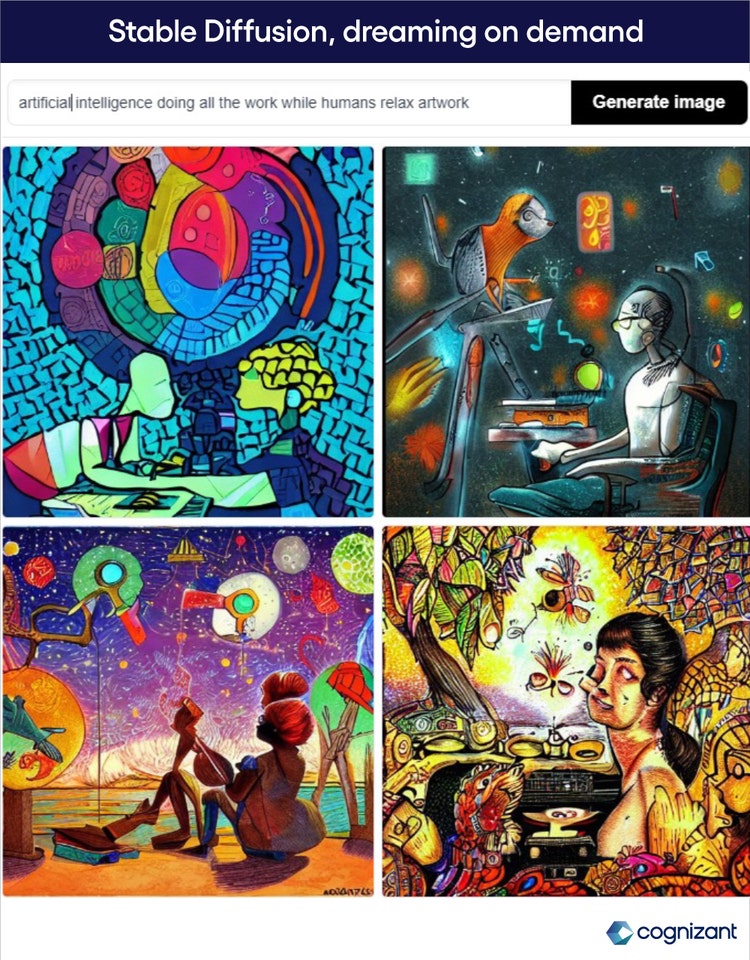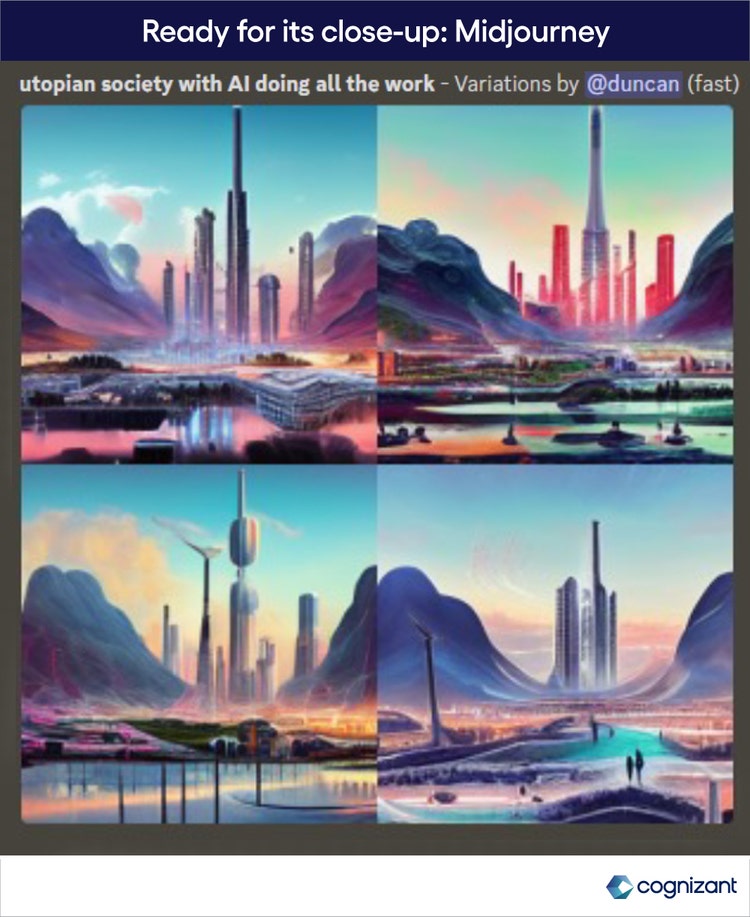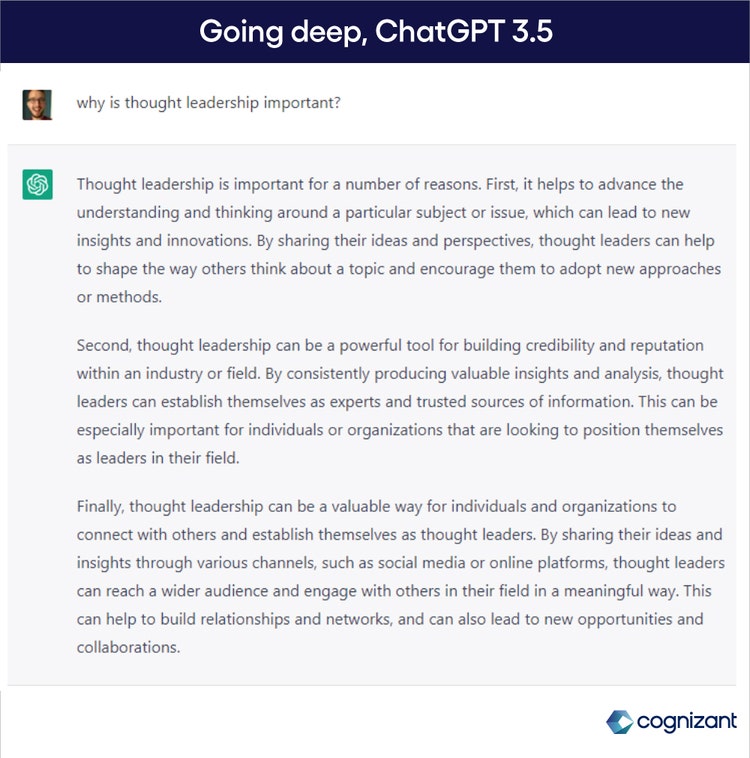
ChatGPT and the generative AI revolution styles-text-white
<p><br> January 30, 2023</p>
ChatGPT and the generative AI revolution
<p><b>Doing business in the age of creative machines.</b></p>
<p>Unless you’ve been living under a rock since November, you’re probably familiar with the term generative AI. This startling technology, which harnesses the data-crunching brawn of artificial intelligence to generate original text, images or other content is already being talked about as the next great technological revolution, a world-changing upheaval to rival or even eclipse that of the Internet in the 1990s. Last week in Davos, Switzerland, generative AI dominated discussions at the World Economic Forum, with giddy business titans and tech gurus touting its potential to transform not only how we communicate and entertain ourselves, but the way we think, make decisions, and even wage war. Microsoft CEO Satya Nadella spoke glowingly of generative AI’s potential to democratize the creative process, enhance human productivity, and help those short on resources ‘do more with less.’<br> </p> <p>Not everyone is excited. Even before Open AI released the jaw dropping ChatGPT 3.5 chatbot, some artists and writers, fearing for their jobs, were campaigning online against galleries and platforms that showcased generative AI content. Looking forward, it’s hard to see how generative AI won’t soon also be replicating the work of journalists, programmers, copywriters and more. For those who like their nightmares quantified, this month’s Atlantic cites an Oxford University projection that precisely <a href="https://www.theatlantic.com/ideas/archive/2023/01/chatgpt-ai-economy-automation-jobs/672767/" target="_blank">47% of U.S. white collar jobs would disappear</a> in a fully generative AI-fied world.</p> <p>Who’s right? When the dust settles from phase one of the generative AI revolution, will history have vindicated the utopians or the doommongers?</p> <p>It’s way too early to say. But we can, already, venture some educated guesses as to what this technology may mean in the medium- to short-term for businesses, employees, and customers.</p> <h4>What is generative AI?</h4> <p>Before generative AI can generate anything, it does what all artificial intelligence does: train itself on a large set of existing data, taking note of recurring patterns and correspondences. Those observations are compiled into an index of rules and parameters called a ‘model.’ Though the model cannot think, the sheer volume of data at its disposal, coupled with godlike processing speed, lets a conventional AI model spot patterns and find meaning in subsequent sets that would elude even the smartest, most experienced human analyst.</p> <p>But a generative AI model doesn’t feast on fresh data sets—not big ones, anyway. It takes its input in the form of a short ‘prompt’ from a human user (example), then uses its vast learned index of rules, facts and principles to produce content that conforms to what the model has taught itself about human tastes and expectations. Before ChatGPT went prime time in November, image-generators like Dall-E, Stable diffusion and Midjourney were dropping jaws online with incredibly detailed and dare we say it, even beautiful images, prompted either by snippets of text, or images, supplied by the user.</p>

#
<p><span class="small">Figure 1<br> </span></p>

#
<p><span class="small">Figure 2</span></p> <p>These products use different AI models to produce content in different mediums, but the principle is the same: the AI trains itself on a huge dataset of existing material—literal billions of artworks harvested from the Internet, in the case of Dall-E—then uses human prompts to generate new, original material that the user can then tweak and refine ad infinitum with more prompting.<br> </p> <p>As the framework of using a data set, user prompt, and AI to generate new content continues to evolve, models are springing up that can produce work in other mediums, such as 3D assets for virtual environments. OpenAI has even developed a functioning, if unrefined, music generator called <a href="https://openai.com/blog/jukebox/" target="_blank" rel="noopener noreferrer">Jukebox</a>.</p> <p>So why does ChatGPT get all the headlines? It didn’t, initially. OpenAI’s first white paper on the power of <a href="https://openai.com/blog/language-unsupervised/" target="_blank" rel="noopener noreferrer">Generative Pre-Training</a> dates to 2018. Even after Microsoft announced in 2020 that it had licensed exclusive use and access to the GPT-3 model, discussions of the news were still largely confined to AI blogs and tech-investor Subreddits.</p> <p>However, in 2022, the model started learning in a new way, using so-called ‘human preference training’ to incorporate the feedback of actual flesh-and-blood users into its learning loop. The results were immediate, and startling. The version of ChatGPT released in November—version 3.5—had fully cleansed itself of its predecessor’s stiltedness and could write and converse with a remarkably human fluency.</p>

#
<p><span class="small">Figure 3</span></p> <p>Within weeks, a million users had signed up for free Chat GPT accounts—the system is currently not accepting new users—and discussions of generative AI’s potential made the leap from tech blogs to mainstream publications like the <i>Washington Post</i>, which by January was dispensing such deep-in-the-weeds advice as “How to use ChatGPT to text or Tinder without being a jerk.” Generative AI, in other words, has already changed the texture of people’s lives—if only in the wild proliferation of content being created and shared on social media. But the applications for big business could be even more profound.<br> </p> <h4>How can businesses use generative AI?</h4> <p>As with any new technology, generative AI’s first wave of users are still wallowing in its novelty, and experimenting to test its limits, but more stable, scalable, and commercial products are already in development. First to market have been products such as avatar creators and copywriting tools, but larger-scale, industrial and consumer applications are sure to follow. Here are some potential ways in which generative AI will likely scale and reach a wider audience:</p> <ul> <li><b>Personalized product design</b><br> <br> Generative AI is inherently personalized, as the prompts that drive the content creation process are provided by the user. This means that any content produced using generative AI is tailored to their specific interests, which can have a number of benefits for businesses. For example, generative AI could be used to create personalized images based on a company's intellectual property, which could be placed on items like T-shirts, bedsheets, and wallpaper. This would allow businesses to offer unique, customized products that appeal to a wider range of consumers.<br> <br> Building on this, as 3d printing has become more prevalent in the home, it’s conceivable that items like models, kitchenware, wall mounts and even furniture could be designed through AI and then manufactured at home, or at least locally. Companies that can build offerings around this level of personalization through AI models will stand a much better chance of not being disrupted by them.<br> <br> While generative AI lets untrained customers perform feats of artistic creation, it isn’t limited to creating visual or text-based content. By training on different sets of financial or insurance products, for example, gen AI could soon be used to create personalized mortgages or insurance coverage, where the prompt is detailed user data.<br> <br> </li> <li><b>Knowledge and resource management</b><br> <br> Businesses generate a huge amount of information and documentation through their daily activities and processes. But managing this information and keeping it available in an accessible, clearly written form is a perpetual challenge. By training AI models on this unstructured information, it will be much easier for employees to access the knowledge they need, whether it's related to the company, a business area, or a specific project. An AI chatbot like ChatGPT could not only provide employees with access to the information they need, but keep that documentation updated, and generate new documentation on the fly, reducing the need for dedicated support staff. This could not only make it easier for employees to do their jobs, but also help streamline business processes and improve efficiency across the board.<br> <br> </li> <li><b>Empowering decision-makers</b><br> <br> AI has long been heralded to understand large data sets and make better decisions as a result, however the scale of its use in this capacity could arguably be much more widespread. But gen AI, which can not only interpret data but present its findings in clear, conversational language, raises the prospect of AI not just <i>assisting</i> the decision-making process, but participating in it. Over time this will only enhance ability of organizations to become more data driven as the process is embedded into day-to-day operations.<br> <br> </li> <li><b>AI assistance</b><br> <br> Google, Amazon, Apple and more have all produced very capable, if in some ways limited AI assistants over the years. Preceding this, Microsoft infamously created Clippy, and readers of a certain age will either treasure their time together or wish it good riddance. It’s feasible Clippy, or something like it could make a return, however with the news that Microsoft have invested <a href="https://blogs.microsoft.com/blog/2023/01/23/microsoftandopenaiextendpartnership/" target="_blank" rel="noopener noreferrer">$10B</a> in OpenAI and plan to incorporate ChatGPT into their core Office products and even Bing search. This begs the question of further integrations of generative AI with other software, both enterprise and not. Generative AI incorporated with image editing software to assist designers, or even SAP to help with a three-way matching process. The opportunities are endless.</li> </ul> <h4>The road ahead</h4> <p>All the above comes with no small amount of risk, for humanity as a whole in the long term, but more immediately for businesses itching to put generative AI to work. While the technology is impressive, it is far from perfect. The current data set is static, it does not know that Queen Elizabeth the 2<sup>nd</sup> has died, for example. And when generative AI does make mistakes, what’s more, its tendency is to be "confidently incorrect," promoting falsehoods and misinformation with the full weight of its deep knowledge base and its newly acquired talents for persuasion. This is a significant concern given the inherent biases that have already been detected in some AI models and will only be amplified as gen AI expands in its reach.</p> <p>Some artists have questioned the legality of having their work used to train AI that may ultimately replace them, simply because their images have been uploaded to the internet. Although the generated artwork does not violate their copyright, the AI would not be able to function without the initial information it has been trained on. Similarly, text generated by AI may repeat ideas it has been trained on, potentially causing problems for users if the output is published, even though it is not necessarily plagiaristic. These issues have led to calls for watermarks on AI generated content, with China even <a href="https://arstechnica.com/information-technology/2022/12/china-bans-ai-generated-media-without-watermarks/" target="_blank" rel="noopener noreferrer">banning</a> content that does not have one.</p> <p>And then there’s the biggest risk of all: the sheer unknowability of what life, society and business will be like when "the generative AI revolution” becomes an upheaval we can look back on as an event with something resembling an end point. On this, it’s hard not share both the excitement of the Davos visionaries, <i>and</i> the concerns of white-collar knowledge workers staring down the barrel not only of job loss unemployment, but of irreversible obsolescence.</p> <p>Yet the case for a cautious optimism is compelling. Yes, generative AI holds the promise to be something more than just another technological revolution—never before has it felt like the essential nature of being human was on the table, our ‘specialness’ as a species up for grabs. But a revolution in technology it will be, nonetheless, and technology has an essential nature of its own: enhancing the ability of humans to do the things they do best. Will the coming revolution prove the first exception to that so-far unbroken rule? Probably not—and at this point, there is no going back. The gen AI is out of the bottle.</p> <p><i>To learn more, visit the </i><a href="https://www.cognizant.com/us/en/insights/tech-to-watch" target="_blank" rel="noopener noreferrer"><i>Tech to Watch</i></a><i> section of our website or <a href="https://www.cognizant.com/us/en/about-cognizant/contact-us" target="_blank" rel="noopener noreferrer">contact us</a>.</i></p> <p><i>This article is written by Duncan Roberts, Senior Manager in Cognizant Research.</i></p>
<p>We’re here to offer you practical and unique solutions to today’s most pressing technology challenges. Across industries and markets, get inspired today for success tomorrow.</p>
